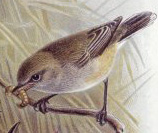- Grey Warbler
Taxobox
name = Grey Warbler

status = LC | status_system = IUCN3.1
regnum =Animalia
phylum =Chordata
classis =Aves
ordo =Passeriformes
familia =Acanthizidae
genus = "Gerygone "
species = "G. igata"
binomial = "Gerygone igata"
binomial_authority = (Quoy & Gaimard, 1830)
synonyms =The Grey Warbler or Riroriro, "Gerygone igata" is a species of insectivorous bird in the
Acanthizidae family endemic toNew Zealand .Its naturalhabitat is temperateforest s.Description
Smaller than the
Silvereye weighing about 6.5 grams this 11cm long bird is grey-brown (tending to olive green tint) above and has a pale grey face, throat and breast and has an off white abdomen, tinged with yellow. The tail is white underneath and dark brown on top with white tips visible in flight, it also has a distinctive ruby-red eye. The female has similar plumage but is smaller in size. The young are paler with no hint of yellow and have brown eyes. The male's song often starts with a series of three squeaks and builds into a distinctive long plaintive wavering trill that rises and falls. They sing throughout the year but most vigorously, when nesting, during spring. More commonly heard than seen.Distribution and habitat
Common throughout New Zealand main islands and many off-shore islands, absent from open country and alpine areas. At home in native and exotic forests it may be found almost anywhere there is some tree or shrub cover.
Behaviour
Diet
Grey warblers mainly feed upon spiders, insects and their larvae. They are very active, almost never still but they can hover mid-air as they flit from perch to perch in search of food.
Nesting
Grey warblers are unique among New Zealand birds in building a pear-shaped structure with a side entrance near the top. Although the male collects material, the nest itself is constructed by the female from grass, leaves, rootlets and moss, held together with spider web threads. It is constructed anywhere from 2 to 25 feet above the ground, and is lined with feathers and other soft material. It is attached to a twig at the top, but is often also secured at the back or sides well. Although not involved in nest building or incubation, the the male helps to feed both nestlings and fledglings. The 3 to 6 eggs, each laid 2 days apart, are pinkish-white with fine reddish-brown speckles all over. The eggs, weighing 1.5 grams are about 17 millimetres long and 12 millimetres wide. Incubation takes about 19 days and the chicks spend another 15 to 19 days in the nest.
Their breeding season is from August to January and they usually manage two clutches, but the
Shining Cuckoo often parasitises this second clutch leaving a single egg for the warblers to incubate and rear.References
* BirdLife International 2004. [http://www.iucnredlist.org/search/details.php/50898/all Gerygone igata] . [http://www.iucnredlist.org 2006 IUCN Red List of Threatened Species. ] Downloaded on 26 July 2007.
* NZ Royal Forest and Bird Protection Society, Nov 2003 [http://www.forestandbird.org.nz/publications/magazine/2003/november/SecretiveSongster.asp]
* [http://www.nzetc.org/tm/scholarly/tei-BulBird-t1-g1-t1-body-d0-d13.html Gerygone Flaviventris. — (Grey Warbler.) | NZETC]
Wikimedia Foundation. 2010.
